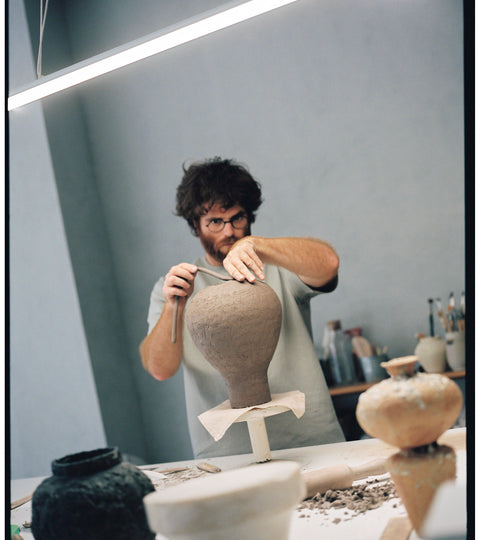Meeting Canoa Lab
What brought you to the clay material?
Ever since we met, we’ve worked together on many projects, which have enabled us to carry out continuous research in different but convergent directions derived from the painting and sculpting fields, always wondering about the irrefutable space-time relationship. After several years of work in which we combined our most plastic production with image projects linked to photography, video, graphics and art, we came across metal and clay, two materials which, as they are closely connected, caught our attention both in terms of their durability and because they have undoubtedly marked the development of our society.

Being a couple of makers, is every piece four hands made? Is one of you more into shape, one more into glazing, into photography...? Take us through your creative process!
Every piece is four hands made. Raquel is more focused on n.3 and Arq series and Pedro is focused on our Isolated pieces but we both polish and do other processes. Pedro is also in charge of the glazing and kiln and Raquel develops the metal pieces that some of our designs have. It could be said that all other processes are done/conceived together and in the same direction. We have been doing this for many years and we are well coordinated.

Where do you get your inspiration from?
Our focus has a strong naturalistic and historical character. We find the ancient forms and ancestral ways of production that really interest us throughout different times in history. We continually observe primitive designs produced with as few tools as possible, and above all, we pay special attention to Iberian, Roman and Greek designs, which are an intrinsic part of our Mediterranean culture. Looking at what surrounds us, we find textures, colours and shapes that the natural world offers if you dedicate enough time to its observation.

How does being based in Valencia (Spain) impact your creativity and your productions?
Valencia makes us stay closer to pottery tradition, the Mediterranean sea and its light, natural colors and classical shapes. This city is some kind of “catalyst” of all the references that we find when we travel and all the research we do before designing a piece and allow us to create our own archive.
Can you tell us a bit more about the pieces selected for Volume Ceramics?
The pieces corresponding to our n.3 series that you have selected are made using the press molding technique and are inspire on different types of Greek vases: , Anfora, Hidria y Psycter with glazing that reminds us of the sand and minerals. The pieces corresponding to our Isolated series are larger and are made using the coiling technique. For all these vases we use self-formulated glazes and local clay from a neighbour village (Manises).

Do you listen to music while working? Share with us your playlist at the studio ☺
Quite different, we love music and we think that music diversity enriches our creative pratice. Depending on the day and the mood it could be jazz, electronic or ambient music. Some our very favourite are Miles Davis, Tom Waits, Nick Cave, Dee Dee Bridgewater or Melissa Aldana.
Where do you see your practice headed in the future?
It is difficult to know where we are going. We like to say that the bow and stern of our boat are quite the same and we then sail according to our daily decisions, trying to make our studio and family grow in a natural and respectful way for us and our environment.
Acheter des pièces de Canoa Lab
(crédits images : Claudia Maurino)

